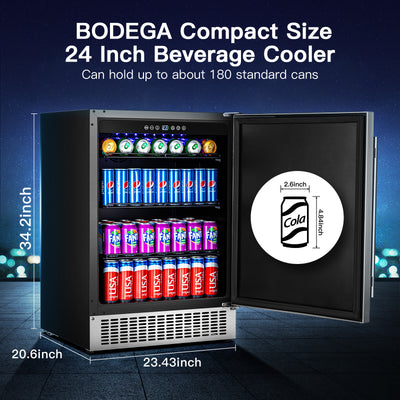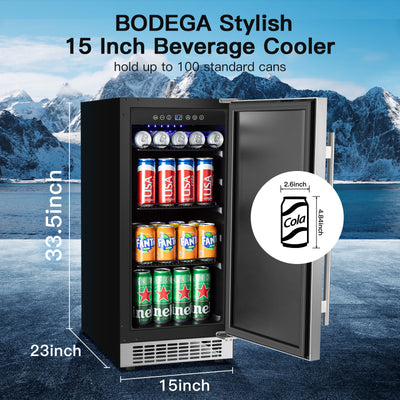Introduction
Beverage fridges have become an indispensable addition to modern kitchens and entertainment spaces, providing the perfect chilling solution for drinks and refreshments. However, encountering issues with cooling performance can be frustrating, especially when your beverages are not reaching the desired temperature. In this article, we'll delve into the mechanics of beverage fridges, explore common reasons for insufficient cooling, and provide maintenance and troubleshooting tips to ensure your drinks are always refreshingly cold.
Understanding Beverage Fridge Mechanics
Cooling System Components
Beverage fridges operate on a cooling system similar to standard refrigerators, consisting of a compressor, condenser coils, evaporator coils, and refrigerant. These components work together to remove heat from the interior of the fridge, maintaining a consistently low temperature to keep your beverages chilled.
Factors Affecting Cooling Efficiency
Several factors can impact the cooling efficiency of your beverage fridge. These include the ambient room temperature, the frequency of door openings, the placement of items inside the fridge, and the cleanliness of crucial components like coils and vents.
See also: Why Your Wine Cooler Is Not Cooling?
Common Reasons for Insufficient Cooling
Incorrect Temperature Settings
One common culprit behind a beverage fridge not getting cold enough is incorrect temperature settings. Ensure that the thermostat is set to the appropriate level for chilling beverages, typically around 36 to 38 degrees Fahrenheit (2 to 3 degrees Celsius). Setting the temperature too high or too low can result in inadequate cooling.
Overcrowding and Poor Air Circulation
Overcrowding the beverage fridge or blocking the air circulation vents can hinder the proper distribution of cold air. When items are packed tightly or obstructing airflow, the fridge's cooling system struggles to maintain the desired temperature.

Maintenance and Care Tips for Optimal Cooling
Regular Cleaning of Coils
The condenser coils, located either at the back or underneath the beverage fridge, play a crucial role in heat exchange. Over time, these coils can accumulate dust and debris, reducing their efficiency. Regularly clean the coils with a brush or vacuum to ensure optimal heat dissipation.
Proper Placement of Items
Be mindful of how you arrange items inside the beverage fridge. Avoid placing warm or hot items directly into the fridge, as this can elevate the internal temperature and impact overall cooling performance. Allow items to cool to room temperature before placing them inside.
Rearranging Contents
Inspect the interior of your beverage fridge and ensure that there are no items obstructing the air vents. Rearrange the contents to ensure proper airflow throughout the fridge. This simple step can significantly improve cooling performance.
Clearing Obstructions
If you find any items blocking the air vents, promptly remove them to allow cold air to circulate freely. Proper airflow is essential for maintaining consistent temperatures and optimal cooling.

Troubleshooting Other Possible Issues
Damaged Door Seals
Worn or damaged door seals can lead to air leakage, causing the beverage fridge to work harder to maintain its temperature. Check the door seals for any cracks or gaps, and replace them if necessary to ensure a tight seal.
Ambient Temperature
The ambient temperature of the room in which the beverage fridge is placed can impact its cooling efficiency. Ensure that the fridge is not exposed to direct sunlight or placed in areas with high ambient temperatures.
Allowing Time for Temperature Change
It's important to note that temperature changes in a beverage fridge might not be immediate. It might take a few hours for the internal temperature to stabilize after adjusting the thermostat. Patience is key when waiting for temperature adjustments to take effect.
Seeking Professional Help
Complex Repairs
If the troubleshooting steps mentioned above do not resolve the cooling issue, it's advisable to seek professional assistance. Complex repairs might be required to address underlying problems with the cooling system.
Expert Repairs and Assistance
In cases where components such as the compressor or refrigerant need attention, seeking professional repairs is advisable. Handling refrigerants requires expertise and specialized equipment, and a technician can accurately diagnose and address the problem.
Conclusion
A properly functioning beverage fridge is essential for enjoying your drinks at the perfect temperature. If you find your beverage fridge not cooling effectively, the first step is to check thermostat settings and ensure proper airflow. If issues persist, don't hesitate to seek professional help. By understanding the mechanics of your beverage fridge and implementing practical solutions, you can ensure that your refreshing drinks remain cool and enjoyable.
FAQs
Why is my beverage fridge running but not cold?
- This could be due to various factors, including incorrect temperature settings, poor air circulation, or malfunctioning components.
How can I determine the ideal temperature setting for my beverages?
- Aim for a temperature between 36 and 38 degrees Fahrenheit (2 to 3 degrees Celsius) to ensure optimal beverage chilling.
Can placing warm items directly into the fridge affect its cooling?
- Yes, placing warm items can impact cooling efficiency. Allow items to cool to room temperature before placing them inside.
How frequently should I clean the coils of my beverage fridge?
- Cleaning the coils every three to six months is recommended to maintain efficient heat exchange.
Is it normal for the beverage fridge to make occasional noises?
- Some operational noises are normal, but loud or persistent noises could indicate an issue that requires attention.








